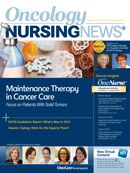Nurses Have Key Role in Managing Side Effects of Maintenance Therapy
More and more, as the use of maintenance therapy increases, oncology nurses are tasked with monitoring how the strategy is working for specific patients.
Susan J. Keen, RN, OCN
Deborah L. Selm-Orr,
RN, MS, CRNP, AOCN
What is the value of maintenance therapy in patients with lung or breast cancers, and how and when should it be used?
Within the research community, debate continues as data demonstrating improved health outcomes are weighed against the costs of treatment.
Oncology nurses have the same concerns, but on a more granular level. More and more, as the use of maintenance therapy (MT) increases, they’re tasked with monitoring how the strategy is working for specific patients.
The trend means nurses must be aware of the side effects that can arise with the long-term use of such medications, and be prepared to step in and help, two oncology nurses said.
Fatigue is a common side effect of MT for patients with lung cancer, whether they’re taking a cytotoxic drug such as gemcitabine or a targeted therapy such as erlotinib, said Susan J. Keen, RN, OCN, a thoracic nurse navigator at Thomas Johns Cancer Hospital in Richmond, Virginia. And bevacizumab MT in patients with lung cancer can spark hypertension, added Deborah L. Selm-Orr, RN, MS, CRNP, AOCN, of Cancer Treatment Centers of America at Eastern Regional Medical Center in Philadelphia.
“Nurses need to know what the potential side effects are, how to manage them, and what types of teaching the patient will need in order to be aware and empowered,” Selm-Orr said.
Monitoring such patients can present challenges for oncology nurses, who must find creative ways to ensure that MT outpatients remember to take their medications and report side effects, Selm-Orr said.
“Most people have a smart phone with a camera, so if they say their feet are hurting, I ask them to take a picture of their feet so I can see what they look like,” she said.
Checking in on patients can also mean helping them deal with their frustrations about cancer treatment, including uncertainty about how long they’ll be on a medication like bevacizumab, for which the timing of MT is not fixed, Selm-Orr said.
In fact, patients often question whether to begin such a therapy at all, questioning whether MT will make a difference in the course of their disease and be worth the side effects that come with it, said Keen, who helps to facilitate a survivors’ group for patients with lung cancer.
“I always tell my patients to try it, so they know what the results will be,” she said. “But if they’re on the therapy and they’re miserable, it’s not worth it.”
Admittedly, MT is a tough adjustment for many patients, Keen said. “They say, ‘I hate that I can’t do the things I used to.’ We discuss that it’s a new normal, and that everybody has those in their lifetime, even just with age.”
But when MT works, Keen said, patients are typically glad they tried it.
“Those who are on the drug and can manage the side effects say ‘I’m glad I’m above the earth and not below,’” she said. “They’re glad they can still have extra time with their families, see grandchildren or children graduate, or go on a trip they’ve always planned. They have these goals, and as long as they can get out of the bed, they’re OK with it.”




